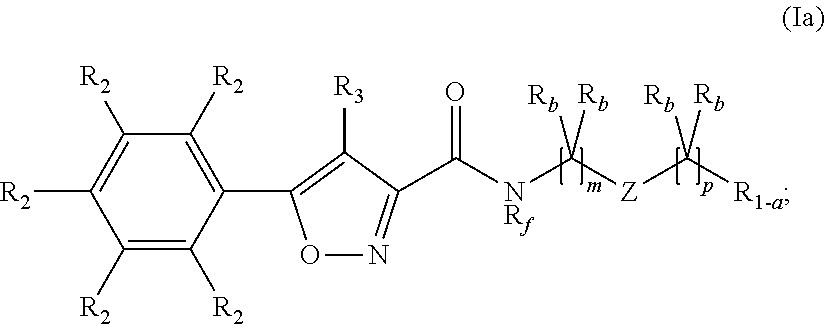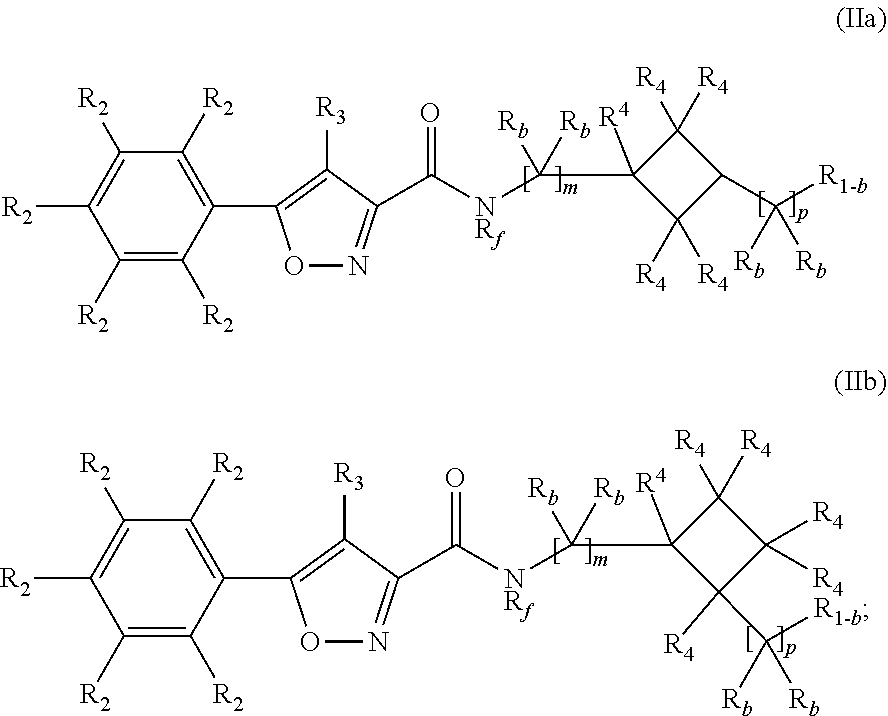Compounds, compositions, and methods for increasing cftr activity
- Summary
- Abstract
- Description
- Claims
- Application Information
AI Technical Summary
Benefits of technology
Problems solved by technology
Method used
Image
Examples
example 1
-(5-(hydroxymethyl)-1H-1,2,3-triazol-1-yl)cyclobutyl)-5-phenylisoxazole-3-carboxamide and N-trans-3-(4-(hydroxymethyl)-1H-1,2,3-triazol-1-yl)cyclobutyl)-5-phenylisoxazole-3-carboxamide
[0216]
Step 1: 3-Amino-cyclobutan-1-one
[0217]SOCl2 (15.6 g, 131.46 mmol) was added dropwise to an ice-cooled solution of 3-oxocyclobutane carboxylic acid (5.0 g, 43.82 mmol) in dry DCM (30 mL) and the reaction mixture was refluxed for 3 h. The reaction mixture was cooled to room temperature and the volatiles were removed under reduced pressure to get the crude compound which was azeotropically distilled with toluene (20 mL×2) to remove acidic traces. The crude compound was dissolved in dry acetone (15 mL) and to the resulting solution was added a solution of NaN3 (5.69 g, 87.64 mmol) in water (20 mL) at 0° C. over 30 min. The reaction mixture was stirred for 1 h at 0° C. and crushed ice was added to the reaction mixture. The aq. phase was extracted with ether (3×50 mL), dried over sodium sulfate and con...
example 2
5-(hydroxymethyl)-1H-1,2,3-triazol-1-yl) cyclobutyl)-5-phenylisoxazole-3-carboxamide and N-cis-3-(4-(hydroxymethyl)-1H-1,2,3-triazol-1-yl) cyclobutyl)-5-phenylisoxazole-3-carboxamide
[0237]
[0238]Step 1: trans-3-((tert-butoxycarbonyl)amino)cyclobutyl 4-nitrobenzoate
[0239]To an ice-cooled solution of tert-butyl (cis-3-hydroxycyclobutyl)carbamate (1.5 g, 80.11 mmol) and 4-nitrobenzoic acid (1.47 g, 88.12 mmol) in dry THF (60 mL) was added triphenyl phosphine (3.15 g, 12.01 mmol) followed by dropwise addition of DIAD (8.09 g, 40.05 mmol) and the reaction mixture was stirred at room temperature for 2 days. Solvent was removed under reduced pressure to get the crude compound which was purified by silica gel (100-200 mesh) column chromatography. Elution with 50% ethyl acetate in n-hexane followed by washing with diethyl ether (4 mL×2) gave the product (2.3 g, 85%) as a white solid. 1H-NMR (400 MHz, CDCl3) δ 8.29-8.27 (q, 2H, J=8.92 Hz), 8.21-8.19 (q, 2H, J=8.92 Hz), 5.37-5.32 (m, 1H), 4.77 ...
example 3
4-((S)-1-hydroxyethyl)-1H-1,2,3-triazol-1-yl)cyclobutyl)-5-phenylisoxazole-3-carboxamide and N-cis-3-(5-((S)-1-hydroxyethyl)-1H-1,2,3-triazol-1-yl)cyclobutyl)-5-phenylisoxazole-3-carboxamide
[0256]were prepared by the procedure described in example 2 using (S)-3-butyn-2-ol.
[0257]Yield: 57% over last 2 steps
N-Cis-3-(5-((S)-1-hydroxyethyl)-1H-1,2,3-triazol-1-yl)cyclobutyl)-5-phenylisoxazole-3-carboxamide
[0258]Appearance: pale pink solid
[0259]Analytical data: 1H-NMR (400 MHz, CDCl3) δ 9.34 (d, 1H, J=7.5 Hz), 7.95-7.92 (m, 2H), 7.61 (s, 1H), 7.59-7.54 (m, 3H), 7.38 (s, 1H), 5.51 (d, 1H, J=5.9 Hz), 4.91-4.85 (m, 2H), 4.40-4.34 (m, 1H), 2.88-2.80 (m, 4H), 1.43 (d, 3H, J=6.5 Hz).
[0260]LC-MS: (M+H)+=354.0
[0261]HPLC purity: 99.84% at 220 nm and 99.80% at 254 nm
N-Cis-3-(4-((S)-1-hydroxyethyl)-1H-1,2,3-triazol-1-yl)cyclobutyl)-5-phenylisoxazole-3-carboxamide
[0262]Appearance: white solid
[0263]1H-NMR (400 MHz, CDCl3) δ 9.26 (d, 1H, J=8.4 Hz), 8.18 (s, 1H), 7.95-7.93 (m, 2H), 7.59-7.53 (m, 3H), 7....
PUM
 Login to View More
Login to View More Abstract
Description
Claims
Application Information
 Login to View More
Login to View More - R&D
- Intellectual Property
- Life Sciences
- Materials
- Tech Scout
- Unparalleled Data Quality
- Higher Quality Content
- 60% Fewer Hallucinations
Browse by: Latest US Patents, China's latest patents, Technical Efficacy Thesaurus, Application Domain, Technology Topic, Popular Technical Reports.
© 2025 PatSnap. All rights reserved.Legal|Privacy policy|Modern Slavery Act Transparency Statement|Sitemap|About US| Contact US: help@patsnap.com



